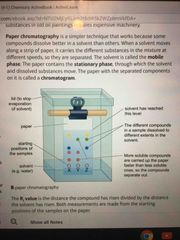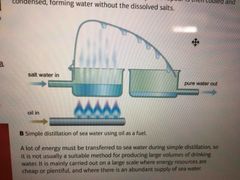![]()
![]()
![]()
Use LEFT and RIGHT arrow keys to navigate between flashcards;
Use UP and DOWN arrow keys to flip the card;
H to show hint;
A reads text to speech;
11 Cards in this Set
- Front
- Back
- 3rd side (hint)
|
What is a pure substance? |
-the composition (way that something is made) cannot be changes and is the same in all parts of a peice of the substance. -when melting, every atom has the same melting point so melts all at the same time. |
|
|
|
What is a compound? |
Compounds can also be pure as the atoms are chemically bonded. You cannot change the composition |
|
|
|
What is a mixture? |
-contains elements and/or compounds -you can use physical processes to separate mixtures into different substances -its composition can change Eg air |
|
|
|
In the solution mining of salt, give the names of the 1)solvent 2)salt 3)solute |
SOLVENT (substance that’s dissolved a solute)- water. SALT (the result you get when all the water evaporates and/or the solution cools, then some solute leaves the solution and salt crystals form)- table salt. SOLUTE ( a substance dissolved in another substance known as the solvent)-salt underground |
|
|
|
How does paper chromatography work? |
When a solvent moves along a strip of paper, it carries the different substances in the mixture at different speeds so they are separates. More soluble compounds carries up the paper faster then less soluble ones. The solvent is called the MOBILE PHASE. The paper contains the STATIONARY PHASE, through which the solvent and dissolved compounds move. The paper with the separated components on it is called a CHROMATOGRAM. |

|
|
|
What is and how do you calculate the Rf value? |
The Rf value is the distance the compound has risen divided but the distance the solvent (eg water) has risen. Both measurements are made from the starting positions of the samples on the paper. Distance moved by spot/ distance moved by solvent. *result is always less than 1 |
|
|
|
What is distillation? |
Used to purify water. When mineral water evaporates, only the water turns into gas as the solid minerals have much higher boiling points and are left behind. The gas is pure water. This can then be condensed to be turned into liquid water again. |
|
|
|
What is fractional distillation? |
Used to separate 2+ liquids. Works because some liquids boil quicker than others. Liquids with lower boiling points evaporate first and turn into vapour first. The hot vapour rises up the column. At first the vapour condenses when it boys the cool glass and drips back down into the flask. As the column heats up there will be a temperature gradient- it will be hottest at the bottom and the temperature will drop as you go further up the column. The fraction with the lowest boiling point will reach the top of the column first and the vapour will pass into the condenser. If you keep heating, fractions with higher boiling points will then rise up the column and can be collected later. |
|
|
|
Purifying sea water with simple distillation |

Water is separated from dissolved salts using simple distillation. Sea water is heated so that water vapour leaves it quickly. This vapour is then cooled and condensed, forming water without the dissolved salts. A lot of energy must be transferred to sea water during simple distillation, so it is not usually a suitable method for producing large volumes of drinking water. It is mainly carried out in a large scale where energy resources are cheap or plentiful, and where there is an abundant supply of sea water. |
|
|
|
Water for chemical anlysis |
Chemical analysis envolées using chemical reactions or sensitive machines to identify and measure the substances in a sample. The water used shouldn’t contain any dissolved salts, otherwise incorrect results will be obtained. Tap water contains sample dissolved salts, which may react to form unexpected cloudy precipitates. These may hide the correct result of the analysis. Also, the machines used for analysis may detect the salts, again leading to an incorrect conclusion. |
|
|
|
Steps to make drinking water |

Sedimentation- small particles are allowed to settle out. Filtration- tanks containing beds of sand and gravel. Chlorination- chlorine kills microorganisms in the treated water. |
|

